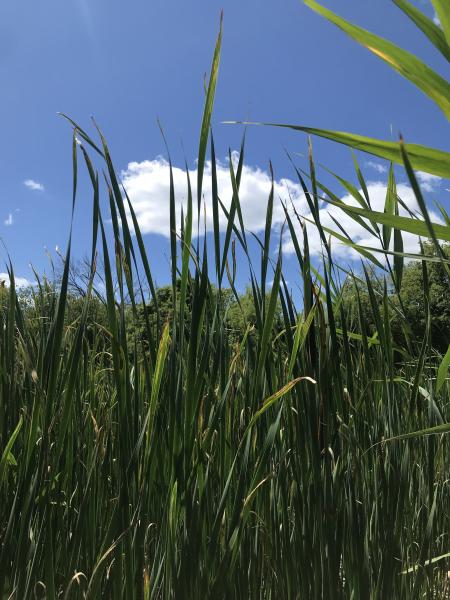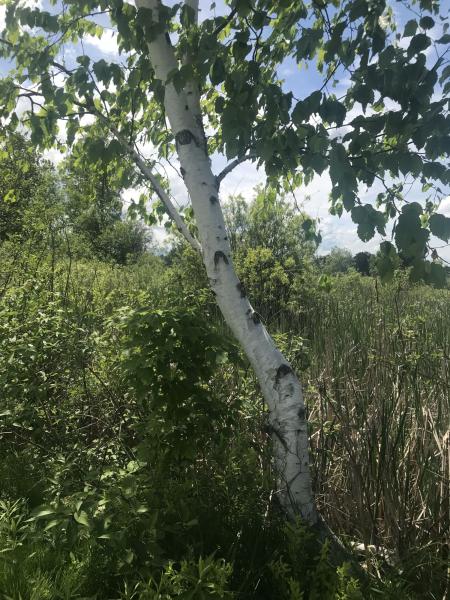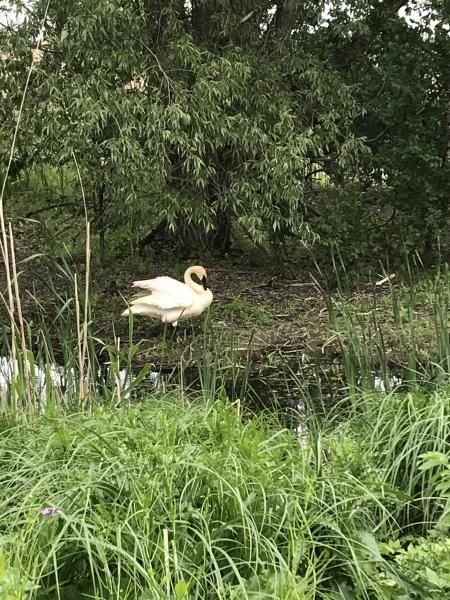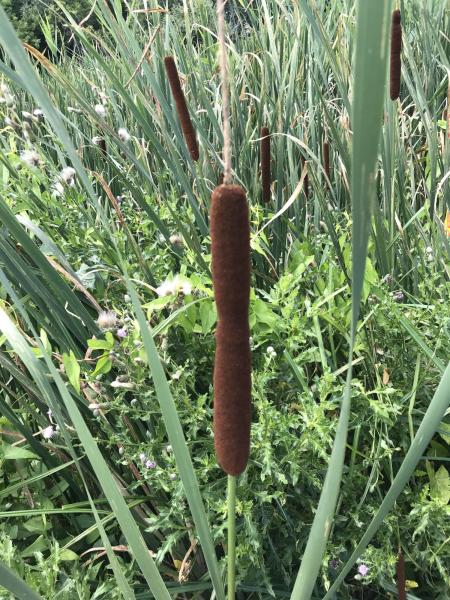Second Marsh is a 137-hectare wetland located in southern Oshawa, where Harmony Creek and Farewell Creek empty into Lake Ontario. Designated as a provincially significant wetland, Area of Natural and Scientific Interest, and a Heritage property, Second Marsh is jointly managed by the City of Oshawa, the Central Lake Ontario Conservation Authority, and the non-profit organizations Friends of Second Marsh and Ducks Unlimited Canada. The marsh is ecologically significant as habitat for 106 species of nesting birds, amphibians, and reptiles, and serves as a nursery for Lake Ontario fish. In the spring and autumn, Second Marsh is also an important stopover location for migrating birds and waterfowl. Second Marsh is accessible to the public via several trail systems that run along the periphery of the Marsh, including Oshawa’s waterfront trail.
Second Marsh is predominantly covered by shallow water plant communities, which are composed of submerged, floating, and emergent aquatic species. These shallow aquatic communities are bordered by marshes and wet meadows that are abundant in cattails, sedges, bulrush, reed canary grass, and bur-reed. These dominants are interspersed with other water loving plants such as jewelweed, hedge-nettle, stinging nettle, wild cucumber, and purple loosestrife.
Deciduous swamps and lowland deciduous forests occur further inland. Ash trees once formed the main canopy in these treed communities, but have experienced significant dieback due to the impacts of emerald ash borer. Within the deciduous forest component, Manitoba maple now makes up most of the tree cover, and grows interspersed with sumac, willows, and buckthorn. Understory plants include garlic mustard, hedge bindweed, jewelweed, wood and stinging nettle, bugleweed, water smartweed, asters, and goldenrods. Deciduous swamps and thicket swamps occur on the north side of the marsh. Dominant swamp tree species include Manitoba maple, birches and poplars, and willows.
The Harmony Creek watershed is part of the ancestral homelands of the Huron-Wendat Nation (also spelled Huronne, Wyandotte, and Wyandot), whose homelands it was from the 1300s or earlier, to mid-1600s, when they relocated to the current location of Wendake, in Québec. The Wendat established several large villages along the route of the Scugog Carrying Place, which is an Indigenous overland trail that connects Lake Ontario to Lake Scugog, and was important for travel and trade. Located at the southern end of the Scugog Carrying place, Second Marsh was an important place for hunting, fishing, and gathering plants. For example, there was a large Wendat village located approximately 2 kilometers north of Second Marsh, beside Harmony Creek, that archaeologists call the Grandview site; residents traveled to the marsh to harvest fish species such as brown bullhead, suckers, sunfish, yellow perch, salmon, trout, and lake whitefish. After the political dispersal and emigration of members of the Wendat nation in the mid-1600s, the ancestors of the Mississauga of Scugog First Nation moved to the Harmony Creek watershed, and continued to harvest animals, fish, birds, and plants for food, medicine, craft & utility from Second Marsh throughout the 1600s and 1700s.
Samuel de Champlain mapped and explored Second Marsh in 1616. During this time, the marsh was significantly deeper than it is now, and was bordered by two ridges, which are glacial drumlins, that run in a north-south direction. From 1750 to 1759, French settlers operated a trading post on the western ridge, which is now known as Gifford Hill. The trading post served participants of the fur trade, including members of the Mississauga nation, and was called Cabine de Plomb because it sold ammunition. Oshawa’s first settler cemetery was built on Gifford Hill in 1816.
From the 1700s throughout the 1900s, activities linked to the encroachment of European settler land management regimes, including land clearing for agriculture, the dumping of dredging materials and wastewater effluent in Harmony Creek, construction of mills and dams, and the construction of Highway 401 and the CNR rail line, heavily impacted the marsh. These activities resulted in increased sedimentation delivery to the marsh, decreasing marsh water depth, deteriorating water quality, and habitat loss.
Second Marsh became a site of contention from the 1970s to 1990s. The Oshawa Harbor Commission had announced plans to dredge the marsh in order to build a deep-water port, but the plan was opposed by environmentalists and anglers. After two decades of protest and advocacy, the ownership of the Marsh was finally transferred to the City of Oshawa in 1993. Since then, several rehabilitation efforts, including planting wetland plant species, removing log jams on Harmony creek, creating fish habitat and more, have been carried out to restore the ecological integrity of the marsh.
The Friends of Second Marsh webpage: Friends of Second Marsh – Connecting People with Nature
The Indigenous History of Tkaronto: https://guides.library.utoronto.ca/Toronto
| English | Latin | Kanienʼkéha | Anishinaabemowin |
|---|---|---|---|
| Common Milkweed | Asclepias syriaca | otshehón:ta, kanon’tínekenhs, tsitsenetse, otshehwèn:ta, kanon’tínekenhs | ninwish, aniniwish |
| Staghorn Sumac | Rhus typhina | tará:kwi | paakwan, baakwaanaatik, baakwaanmizh, ma'kibag, kaagaag-miin-gaawahnshiik |
| Manitoba Maple | Acer negundo | kahwisto’kéha wáhta | adjagobi’mak |
| Burdock | Arctium lappa | ohrohte’kó:wa | zagdebwe, zadebwe |
| Common Milkweed | Asclepias syriaca | otshehón:ta, kanon’tínekenhs, tsitsenetse, otshehwèn:ta, kanon’tínekenhs | ninwish, aniniwish |
| Canada Thistle | Cirsium arvense | ohnyónwara'ko:wa, ohnyón:wara, ohnyó:wara’ | mzaanaatikohns, mazaanaa (-tik, plural), mizaanashk |
| Wild Carrot | Daucus carota | anonhsanónhna, watatewenní:yo otsíhkwa | kaadaakoon |
| Field Horsetail | Equisetum arvense | aweyó:ta | aanikawishkoons, zhiishiibinashk |
| Meadow Horsetail | Equisetum pratense | aweyó:ta | aanikawishkoons, zhiishiibinashk |
| Spotted Jewelweed | Impatiens capensis | ietsi'erorókhstha, yetsi'erorókhstha | gzhiibosegaateaa, makikiibag, wesa’wasga’skonek, ozaawashkojiibik |
| Common Yellow Woodsorrel | Oxalis stricta | teyoratu teyorá:ton | ziiwanabagashk |
| White Spruce | Picea glauca | ohsó:ra onéhta | mina'ig, gaawaandgwaatig, gaa'aandak, gawaandakook, inin'aandakook, gaawaandag |
| Ribwort Plantain | Plantago lanceolata | atenhnéha, teyohahó:ron | onaanigizidaanbag (-oon, plural), ginebigowashk, mashkiigobag, omakakiibag |
| Common plantain | Plantago major | atenhnéha, teyohahó:ron | onaanigizidaanbag (-oon, plural), ginebigowashk, mashkiigobag, omakakiibag |
| Staghorn Sumac | Rhus typhina | tará:kwi | paakwan, baakwaanaatik, baakwaanmizh, ma'kibag, kaagaag-miin-gaawahnshiik |
| Shining Willow | Salix lucida | ó:se, ó:she | sasigopimish, oziisogobimizh, oziisigobimizh (-iik, plural) |
| Canada Goldenrod | Solidago canadensis | otsí:nekwar niyotsi’tsyò:ten | ajidamoowaanow, waabanoominens/waabanoominensag, giizisso mashkiaki |
| Chickweed | Stellaria media | kanakenhseró:roks/kenhnakenhsarò:roks | (check this) |
| Dandelion | Taraxacum officinale | tekaronhyaká:nere | mindemoyanag, doodooshaaboojiibik, mindimooyenh, wezaawaaskwaneg |
| Red Clover | Trifolium pretense | teyonerahtó:ken | miskoaanzo nesoobgak |
| Broadleaf Cattail | Typha latifolia | onó:ta’, onó:ta, otsyawénhsa, osháhrhe, osha'kén:ta | apakweshkway, apakweyashk |
| Stinging Nettle | Urtica dioica | teyutokorúte, yakohesará:tah, óhrhes | bepadji'ckanakiz'itna- zana'tik |
| Common Blue Violet | Viola sororia | tekonnyarotárhoks, tekonteniarotáhrhoks, tewatenyarotárhos | we-waawiyeyaa-bagak, wewaie’bagag, ozhaawashkwaabigwan "blue or green flower/s) |
| Tall Thistle | Cirsium altissimum | Ohnyónwara'ko:wa (bull) | mazaanaa(-tik, plural), mizaanashk |
| Sunchoke | Helianthus tuberosus | ohnennà:ta | ashkibwaa, as'kibwan' |
| Bulrush | Phragmites australis | onó:ta nè:ne kanyatarà:ke watón:nis | apakweshkway |
| Pennsylvania Smartweed | Polygonum pensylvanica | tyononhkwà:tsheros, aweryahsarónyon | ojig'imin |
| Curly Dock | Rumex crispus | ítyete | oza'widji'bik |
| Peachleaf Willow | Salix amygdaloides | ó:se, ó:she | sasigopimish, oziisogobimizh, oziisigobimizh (-iik, plural) |
| Comfrey | Symphytum officinale | yeken'toráhkwa | (check this) |



